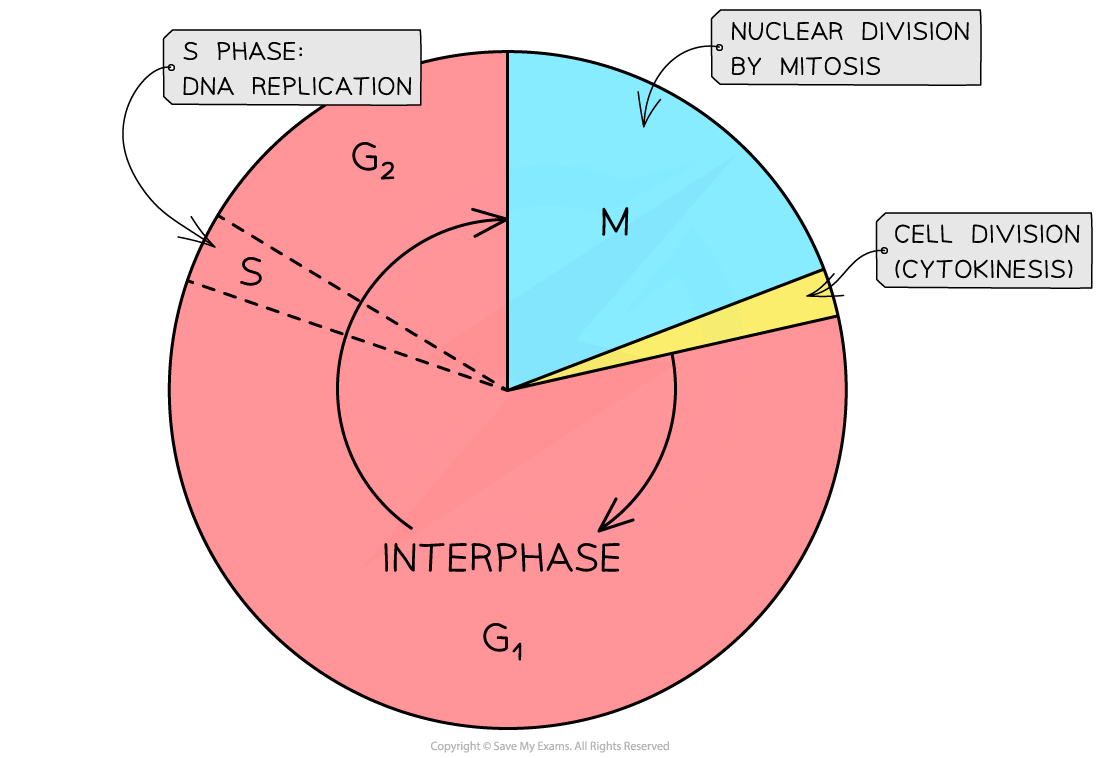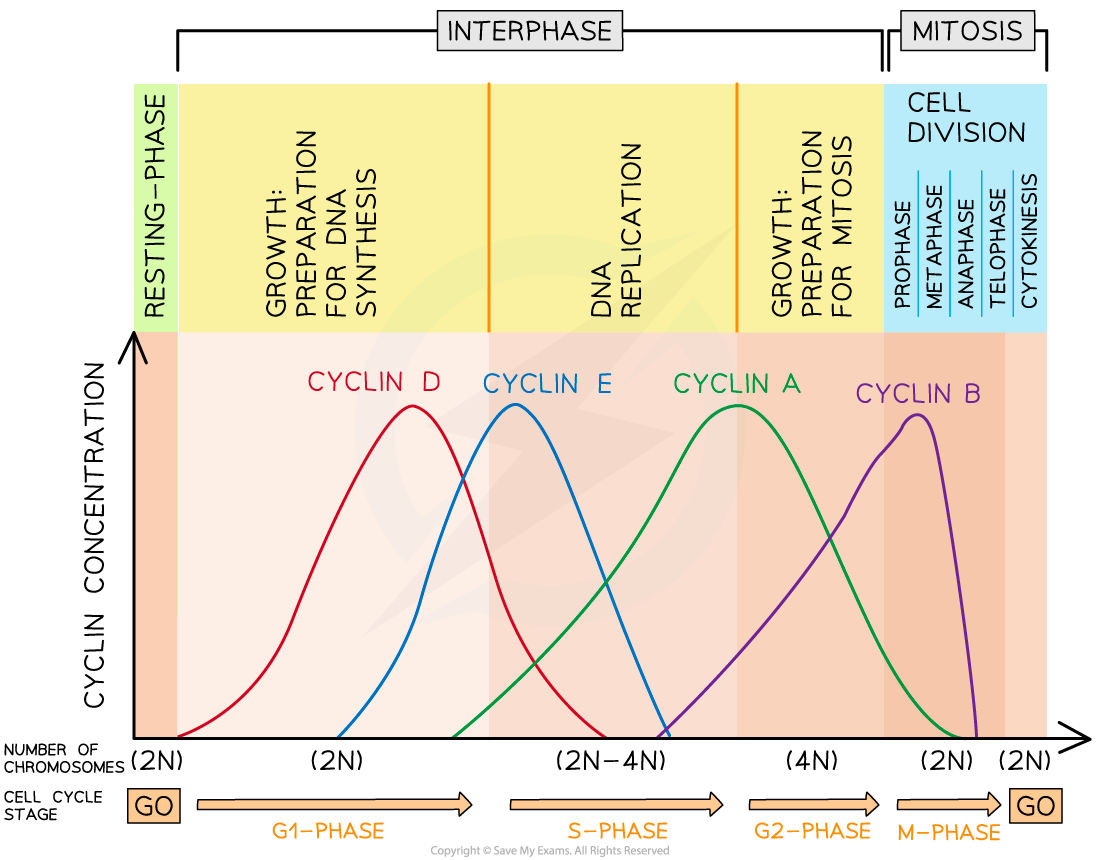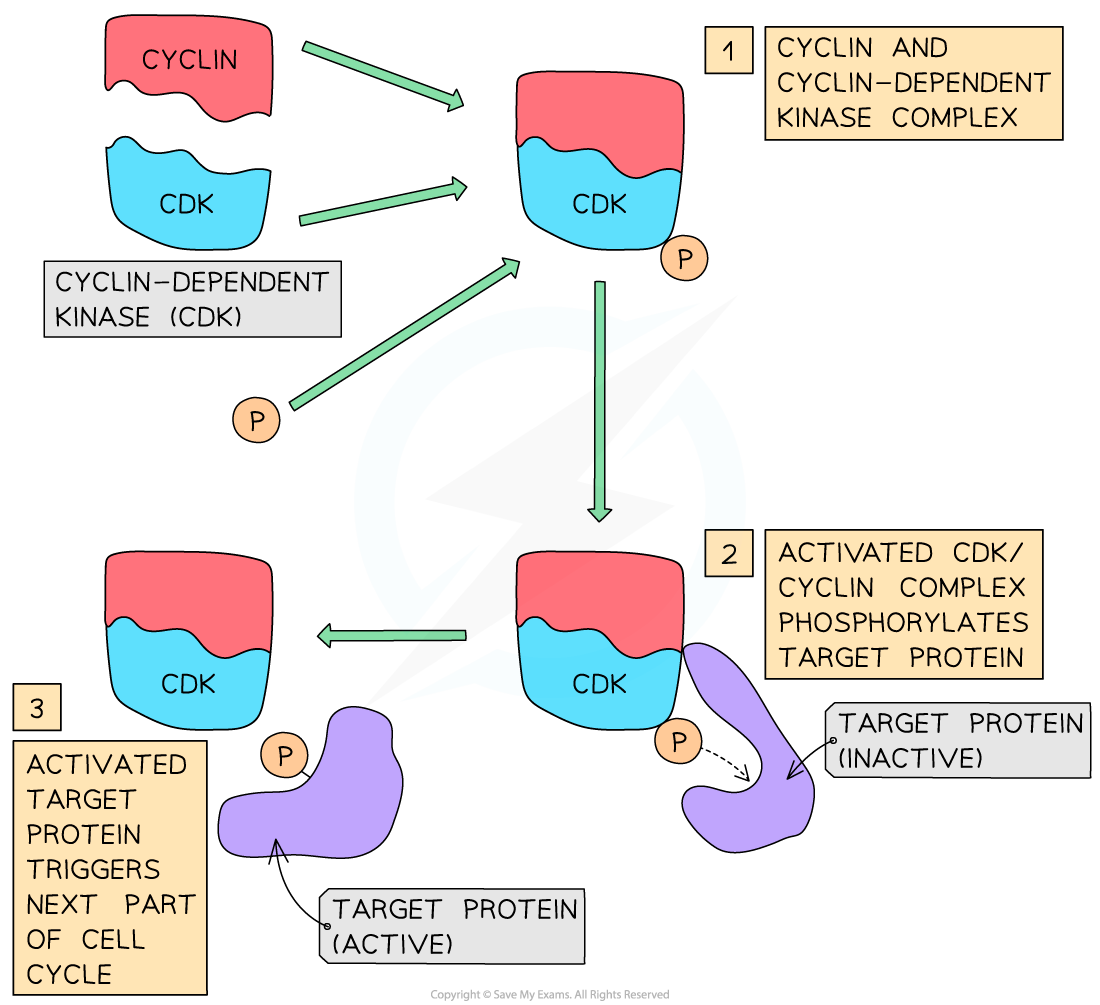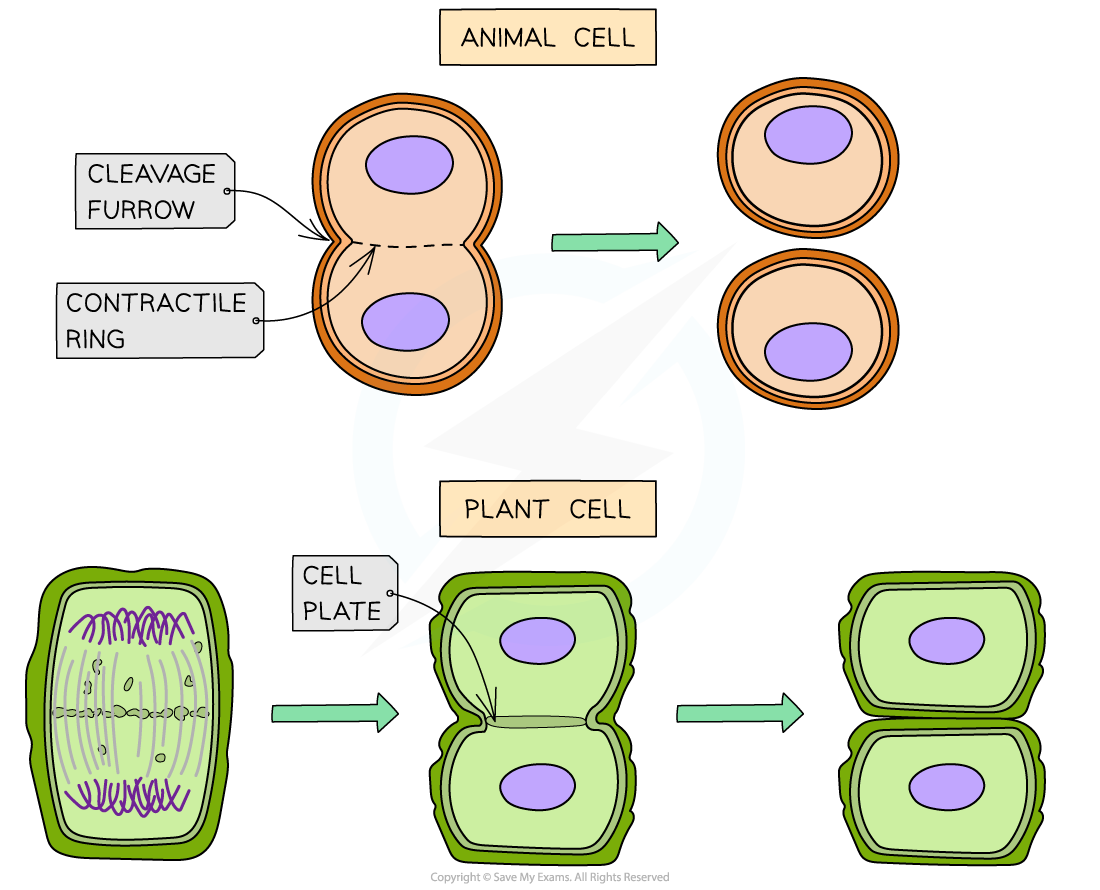Interphase
- Mitosis is part of a precisely controlled process known as the cell cycle
- The cell cycle is the regulated sequence of events that occurs between one cell division and the next
- The cell cycle has three phases:
- interphase
- nuclear division (mitosis)
- cell division (cytokinesis)
- The length of the cell cycle varies depending on:
- The environmental conditions, the cell type and the organism
- For example, onion root tip cells divide once every 20 hours (roughly) but human intestine epithelial cells divide once every 10 hours (roughly)
- The movement from one phase to another is triggered by chemical signals called cyclins

The cell cycle
S = synthesis (of DNA); G = growth; M = mitosis
Interphase
- Interphase is the longest and most active phase of the cell cycle
- During interphase, the cell:
- Increases in mass and size
- Carries out many cellular functions in the nucleus and cytoplasm eg. synthesising proteins and replicating its DNA ready for mitosis (these only occur during interphase)
- Increases the number of mitochondria
- Increases the number of chloroplasts (if they are a plant or algae cell)
The phases of interphase
- Interphase consists of three phases:
- G1 phase
- S phase
- G2 phase
- The gap between the previous cell division and the S phase is called the G1 phase – G stands for growth
- Cells make the RNA, enzymes and other proteins required for growth during the G1 phase
- It is at some point during the G1 phase a signal is received telling the cell to divide again (although some cells do not receive this signal and will never divide; they enter the G0 phase)
- After the G1 phase of interphase the cell enters the next phase of the cell cycle, the S phase – S stands for synthesis (of DNA)
- The S phase is relatively short
- The DNA in the nucleus replicates, resulting in each chromosome consisting of two identical sister chromatids
- Between the S phase and next cell division event the G2 phase occurs
- During the G2 phase, the cell continues to grow and the new DNA that has been synthesised is checked and any errors are usually repaired
- Other preparations for cell division are made (eg. production of tubulin protein, which is used to make microtubules for the mitotic spindle)
- Interphase = G1 + S + G2
Exam Tip
Make sure you know the order of the phases of the cell cycle but also what specifically occurs during the different phases. Don’t forget, interphase is itself made up of three distinct stages (G1, S and G2) and you need to know what happens during each of these.For example, an exam question might ask you to identify the stage of the cell cycle during which a cell would be producing the most mRNA molecules and explain why. The correct answer would be the G1 phase, as this is when protein synthesis is occurring and the production of mRNA occurs during transcription (the first part of protein synthesis).
Cyclins
- The cell cycle is a sequence of stages including interphase (G1, S & G), mitosis and cytokinesis
- The cycle is controlled by cyclins (a group of proteins) and kinases (enzymes)
- There are four different cyclins (D, E, A & B) whose concentrations rise and fall over the cycle:
- D – present first, triggers cells to move from G1 to S phase
- E – highest concentration at the start of S phase, prepares the cell for DNA replication during S phase
- A – highest concentration in G2 phase but activates two different kinases that trigger two processes:
- In the S phase, it activates DNA replication
- In G2 phase, it prepares the cell for mitosis
- B - highest concentration at the beginning of mitosis, promotes the formation of the mitotic spindle

Cyclins control the cell cycle. The presence of certain cyclins triggers a specific stage of the cell cycle.
- When each of the different cyclins reach a certain concentration they trigger the next stage of the cell cycle
- This ensures key processes (e.g. DNA replication, organelle multiplication and protein synthesis) occur at the correct time
- When a specific cyclin has reached a certain concentration it will bind with another group of proteins (cyclin-dependent kinases) forming a complex which is activated
- This complex phosphorylates (attaches a phosphate) a target protein which activates it, causing it to trigger specific functions (e.g. DNA replication)
- Once the specific function is complete the phosphate is released, the cyclin breaks down and the cyclin-dependent kinases become inactive

The mechanism for cell cycle control by cyclins
NOS: Serendipity and scientific discoveries; the discovery of cyclins was accidental
- Some scientific discoveries occur by accident, meaning that the scientist might not necessarily have been deliberately searching for information about the particular mechanism, process, molecule or structure that they ended up discovering
- The discovery of the cyclins was serendipitous (occurred by chance)
- Tim Hunt and his team were researching protein synthesis in sea urchin eggs, however, whilst doing this research they noticed a protein (later named by Hunt as cyclin) that repeatedly increased and decreased in concentration and that these coincided with the phases of the cell cycle
- This discovery led to new research which found the presence of other cyclins and their function as a key factor in the regulation of the cell cycle
Exam Tip
It is important to know the order of the cyclins (DEAB - think dead but with a B of course). When answering questions on which cyclins trigger which stage of the cell cycle it may be easier to sketch a graph. In Biology a well-annotated diagram can get you as many marks as a written answer.
Cytokinesis
Cytokinesis
- Follows the nuclear division (mitosis) phase
- Once the nucleus has divided into two genetically identical nuclei, the cell divides in two with one nucleus moving into each cell to create two genetically identical daughter cells
Mitosis in animal and plant cells
- The process differs slightly in animal and plant cells
- In animal cells:
- A ‘cleavage furrow’ forms and separates the daughter cells
- The cleavage furrow forms when actin and myosin proteins form a contractile ring just under the plasma membrane
- This ring is formed at the equator (centre) of the cell
- As the proteins contract, they pull the plasma membrane towards the centre eventually separating the cell into two daughter cells
- In plants cells:
- A ‘cell plate’ (the precursor to a new cell wall) forms at the equator. Once the cell plate reaches the cell walls of the parent cell, new cell walls are produced, separating the new daughter cells
- The cell plate is formed from vesicles carrying carbohydrates, lipids and proteins fusing together to create the two plasma membranes
- After this other vesicles, carrying pectin and cellulose, deposit these substances by exocytosis in the gap between the two new membranes leading to the formation of new cell walls

Cytokinesis in an animal cell and a plant cell
Exam Tip
Remember that cytokinesis is not a stage in mitosis, it is the last stage of the cell cycle.